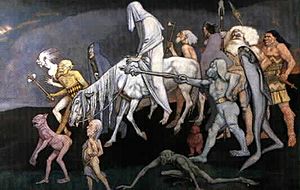Fomorians facts for kids
The Fomorians are a group of powerful, magical beings in Irish mythology. People often describe them as scary monsters. They were thought to live under the sea or deep inside the earth. Sometimes, they were seen as huge giants or fierce sea raiders.
The Fomorians were enemies of the first people who settled in Ireland. They also fought against the Tuatha Dé Danann, another magical group in Irish stories. But it wasn't always simple. Some Fomorians and Tuatha Dé even married each other and had children! They are a bit like the giants in Norse mythology.
Many people believe the Fomorians were like gods of nature's destructive side. They might have represented chaos, darkness, death, or bad weather like droughts. The Tuatha Dé, on the other hand, were seen as gods of growth and civilization.
What's in a Name?
In old Irish stories, the Fomorians were called Fomóire or Fomóiri. If you talked about just one of them, you'd say Fomóir. Today, in modern Irish, they are called Fomhóraigh or Fomhóire. In English, we usually call them Fomorians.
The meaning of their name is a bit of a mystery. Most experts agree that the first part, "Fo", means "under" or "below". The second part is trickier. Some think it comes from the word for "sea", meaning they were "the undersea ones". Others believe it means "great" or "big", so they were "the great ones from below".
A popular idea among scholars is that the name means "underworld demons" or "phantoms". This makes sense because they were often seen as dark and scary beings.
How Fomorians Are Described
At first, people thought Fomorians were evil spirits living in the water or deep underground. Later, they were described as sea raiders. This idea might have come from the real-life Viking raids that happened in Ireland a long time ago.
Fomorians are often shown as monstrous. Some old texts say they had a man's body but a goat's head. Others say they had only one eye, one arm, and one leg.
However, not all Fomorians were ugly. Some, like Elatha and his son Bres, were described as very handsome. These were the ones who had relationships with the Tuatha Dé.
One writer from the 1600s, Geoffrey Keating, even suggested that Fomorians were a seafaring people. He thought they were descendants of Noah's son, Ham.
Famous Fomorians
Here are some of the most well-known Fomorians from Irish myths:
- Indech, who was the King of the Fomorians
- Balor
- Bres
- Cethlenn
- Cichol Gricenchos
- Conand
- Elatha
- Ethniu
- Tethra
- Manannán (sometimes known as the Gilla Decair)
- Tuiri Tortbuillech
- Goll
- Irgoll
- Loscenn-lomm
- Octriallach, son of Indech
- Omna and Bagna
- Regan
See also
 In Spanish: Fomoré para niños
In Spanish: Fomoré para niños


